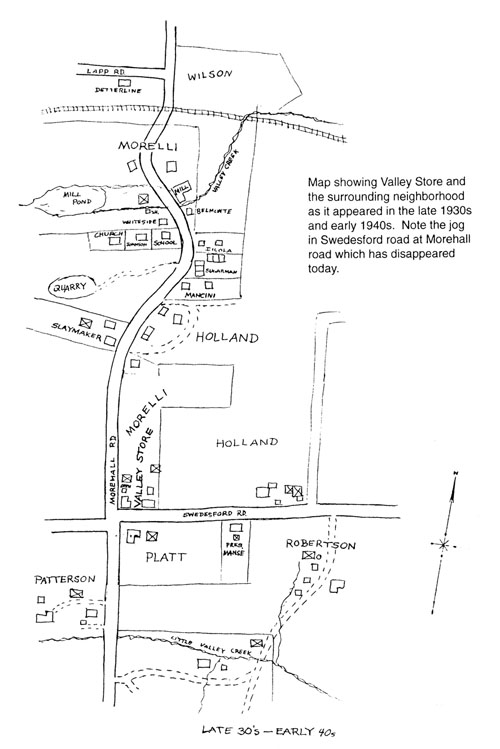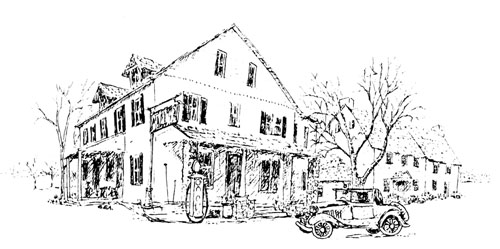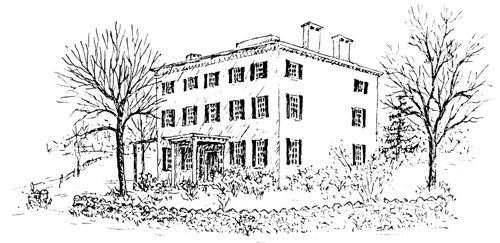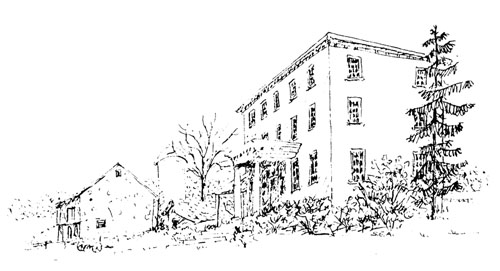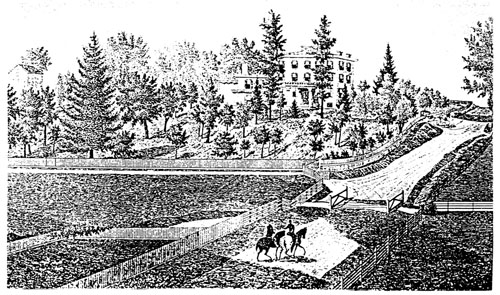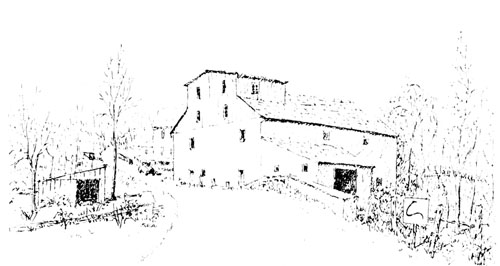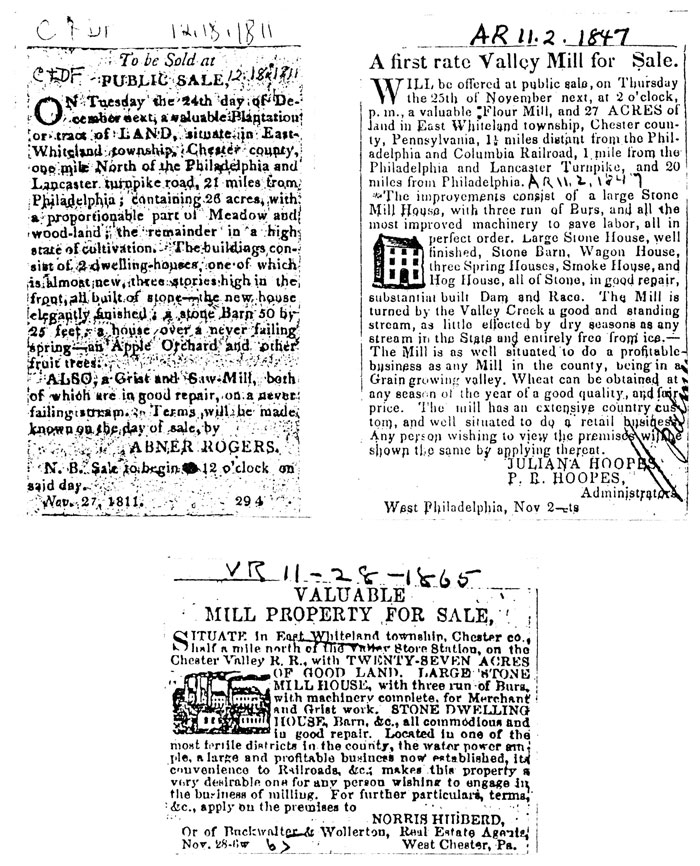|
Home : Quarterly Archives : Volume 36 |
Tredyffrin Easttown Historical Society |
|
Source: April 1998 Volume 36 Number 2, Pages 35–46 Valley Store and Old Morehall Road The Welsh Barony was a large tract of land granted by William Penn to a group of Welshmen who wanted a separate state where they could continue their old world customs and speak their own language. Whiteland Township comprised about one-third of the Welsh Barony. The Barony failed in the 1690s when county lines were drawn across the Welsh territory, and vacant land was sold in smaller parcels to English, Scots, Irish and Germans, who farmed it along with the Welshmen who remained. In 1743 Whiteland was divided into East and West Whiteland Townships. Valley Store is in the eastern most part of East Whiteland, very close to Tredyffrin Township. The Bartholomew family owned much of this part of East Whiteland, as well as hundreds of acres in adjacent western Tredyffrin. The Malin family, which settled in East Whiteland in the early 1700s, was also prominent at this time. Other local names in the 18th century included Coffman, Davis, Hibberd, Lapp, Phillips and Zook. When Bob Goshorn wrote about Warren Tavern Post Office in 1992 (see article on page 47), there were still two buildings standing at the intersection of Morehall and Swedesford Roads: Valley Store on the corner and, close to it on the east side, an older stone house. Valley Store became a crossroads landmark very early in the 19th century and eventually the local post office located there. The first Valley Store burned down and was rebuilt in about 1915. It was a gas station as well as a store during the 1930s-40s. In later years, before it was demolished, it was an apartment building in the midst of the Great Valley Corporate Center.
Map showing Valley Store and the surrounding neighborhood as it appeared in the late 1930s and early 1940s. Note the jog in Swedesford road at Morehall road which has disappeared today.
VALLEY STORE The older building to the east was typical of the farm houses of the Great Valley. It was an 18th century stone building that was added to and, over the course of several generations, more or less doubled in size. The 1912 map shows Valley Store, and 10 acres along Morehall road belonging to the estate of Judson Ruth. John McPhillips owned the old farmhouse next door at that time. Carmine and Mary Morelli, who came to this country in the early 1900s, bought Valley Store and the old farmhouse in 1924. In 1927 "Wm. A" described the neighborhood as it stood in the mid-19th century in a long letter to the editor of the Village Record, "Coming back to the Warren [Tavern] and taking the Valley Store road, came 'Squire John Acker. The Valley Store, kept at that time by 'Squire Isaac King (sage of that locality), Lewis Worthington lived in the mansion across from the store. Reilly's banks, just on down the road, Jonas King and Norris Hibberd's mill beyond; Robert Pandridge next on the right; Robert Todd lived up the road to the left, as did Samuel Lapp and Davis Lapp, and on the road to Devault, on the hill, is the John Fetters ... fine home which is still looked after by the daughters." We do not know the identity of "Wm. A.", but his letter provided a colorful portrait of life around Valley Store at the end of the Civil War and later. He continues: "The period covering the early [18]60s up to '63 were strenuous ones and the country store was the rendezvous for the brain power of the community. War news came through slowly and depended on the arrival of the weekly New York Tribune, Age (Philadelphia), Village Record and such publications for its news. Many old-timers (all gone now) could have told of the many stormy debates worked off at the Valley Store, with 'Squire King in the chair. "After the second Battle of Bull Run, the [number] of brilliant ideas and strategic moves these orators could have furnished to the ones in command of activities on the field would have made Napoleon want to turn farmer.... After the close of our Civil War, and affairs of the country had settled down to work again, the residents of Chester Valley were right on the job, everybody interested in the life of the neighborhood. "A penchant for 'speed' had developed among the younger set and a good 'hoss' was the height of many a chap's ambition. This notion was frowned upon by the older straight laced folks, and comments of Satan's activities were viewed with much concern. "Ed Palmer, residing just north of the Boot, added fuel to the conflagration when he brought 'Long Island Chief ' (a trotting bred stallion) to this section. Dave Worthington [the son of Lewis], just below the Valley Store, owned a bay that was as loose as ashes and had all kinds of speed (in the raw). News of this nature soon spreads and it wasn't long before Palmer had the 'Chief ' rigged to a skeleton wagon, the first vehicle of this nature ever seen about here. "It wasn't long before that stretch of the old Swedesford Road, between Marple Corson's and the Valley Store, was turned into a race track. At this date Valley Store P. O. was one of the strongest in the county (as a rural office). The call for mail after distribution meant quite a gathering of the neighbors. So it wasn't long before the natives (both sporty inclined and otherwise) knew about the days and times the 'brushes' between the two horses generally took place. The old store was filled to capacity on these days. They do say it was quite noticeable how many of the old deacons who had bewailed 'seen doins' actually loitered around for quite a spell after they had received their mail. "The finish of each heat was in front of the store. Every heat contested was a nip and tuck affair, the two horses being pretty evenly matched. Both horses had friends among the crowd of excited spectators. Many hectic arguments result[ed] in reaching after and hauling out a plethoric wallet. As ever, coin of the realm beats 'hot air' to a frazzle. All different opinions were soon settled." Valley Store even had its own band at one time, says J. Gilmore (Duke) Wilson in his book on East Whiteland history. "[Harvey W.] Smith was once a member of the famous Valley Store Band. They kept their carriages and horses in a building behind the ... Store. They practiced on the second floor of this building, and during the middle '80s a school was also held in this upper room. This band had a fancy painted wagon with a very gracefully curved back which permitted the players to sit at various elevations. The body of this famous band wagon was painted red striped with gold. The wheels were also gold. This Valley Store Band Wagon was quite well known because it played at political rallies, strawberry festivals and other social gatherings throughout eastern Chester County." Joe Morelli, Carmine's son, remembers that in the 1930s the store was still a very busy place -- selling dry goods as well as food. There was an outside oven behind the store to the north where his mother made and sold pizzas long before most people knew what they were. There was also a "milk drop" where the farmers could leave their milk. The Worthington House, across Swedesford Road from Valley Store, belonged to Lewis Worthington from 1864 to 1882. At the time he may also have owned the property to the east that later became the airport. He ran a lumber, coal and feed yard nearby at Malin Station, and must have been quite important in the community. Elinor Detterline [T-E Quarterly, Vol. 15, No. 4] reports that "Maplewood" was Lewis Worthington's home. The house was built by Davis Bartholomew, who owned the property from 1820 to about 1850. The land and probably an older house had been in the Bartholomew family from the mid-1700s. Robert and Rebecca Patterson bought it in 1882 from Worthington's widow. In 1912 the
WORTHINGTON HOUSE house and ten acres were owned by Robert Coleman. History Club member Dave Wilson remembers J. Wharton Fultz who lived there during the 1920s. He had a beautiful voice and sang in the Great Valley Presbyterian Church choir. During the 1930s and early '40s it was owned by Elmer Platt. It was called "Fairhaven" when it was bought by the Morelli family in 1956. The manse of the Presbyterian Church still exists just east of where the Worthington house stood. It may have been built right over an old school house, evidence of which disappeared when the manse was built in 1853. A stone school house is mentioned in deeds until 1851. Could it be the Flat School? "Wm. A." says near the end of his letter, "At one time -- a century ago -- friends handed down tell of wonderful things that happened at what was known as the old Flat School House (now destroyed). According to these tales, the harvest moon celebrations held here were wonderful affairs. A day of sports and festivities where the swains sported in new 'coon skin derbies, while the females' millinery mostly running to grass and feathers, cut quite a 'figger'." The John Acker Mansion stood on the west side of Morehall Road a little south of Valley Store. (It seems that Acker was a big name in the Valley in the 19th century, as Bartholomew was a century earlier.) The house was similar in appearance to the Worthington House and about the same age. Elinor Detterline says John Acker was interested in fruit propagation and also planted linden trees and purple beeches.
JOHN ACKER HOUSE Bob Goshorn mentions that Isaac Acker was postmaster in 1851 -- the year Warren Tavern Post Office was moved to Valley Store. Isaac and John were cousins and could have lived in the same house. Isaac was also a cousin of Samuel Acker who lived nearby on Church Road [T-E Quarterly, Vol.35, No. 2], and whose house had cubby holes in the cellar where Isaac could have sorted mail if he had lived with cousin Sam. However, there is reference to a property belonging to Isaac in a sale notice in 1857. There had been an older house on the John Acker property which belonged to Jacob Coffman in 1798. The Direct Tax tells us that the stone house was 33' by 27'. There was also a spring house, a large outside kitchen, a barn and a shop -all of stone. Some of these outbuildings could have survived until recent times. Elinor Detterline says there had been a log house on the property. The 1798 Tax lists a log house belonging to Christian Coffman. He could have been Jacob's brother and lived nearby or on the same farm. Jacob Coffman sold the property of about 100 acres to John Acker in 1830 who sold it to John Harrar in 1880. Stinson Markley, whose photographs have been invaluable to this project, wrote on the back of an old print of the Harrar House, "Note the double bridge [over Little Valley Creek between Valley Store Station and the Harrar House.] The bridge on the right went over the stream, and the driveway on the left. The people could water their horse there. Also the water kept the wooden wheels on all wagons tight, otherwise, it [would] soon require tightening the spokes and rim on
Harrar House, c. 1883, from Futhey & Cope's history. each wheel." In 1933 the farm belonged to William Patterson, who was Richard Patterson's grandfather, Rich, a local farmer who farmed Chesterbrook, and whose father farmed for Lydia Robinson, said that his father grew up nearby on one of the Malin farms and played with the Malin boys. Heading north on Morehall Road -- past Valley Store -- you can go left at the next light and see a stretch of "Old Morehall Road". It is better to continue further north to the other end of Old Morehall and then turn south because of a one-way section. At first you will see the Boathouse, a restaurant and a well-preserved old house (now offices) on the hill to the right. It is the old Fetters farm. In 1798 it was owned by Joseph Kurtz who was a well known Chester county cabinet maker. To go back a few years, in 1717 the house was owned by James David, and later his son Sampson Davis. Other owners before Joseph Kurtz were Christian Feik and John Zook. Lewis Worthington owned it in 1838, where he moved shortly after his marriage to Caroline E. Wilson, daughter of David Wilson Jr. of Tredyffrin. He sold the property to Abraham Fetters in 1861. Mary Ives, a History Club member, remembers the Fetters sisters, Jennie and Elizabeth. Esther Morelli, Carmine's daughter, recalls the area being called "Fetters Hill." As you go south toward Valley Store you can turn right on Lapp Road and see the ruin of a sizable stone house very close to the road. It was burned some years ago by the East Whiteland Fire Co. in a practice drill. On the 1873 map, it is listed as belonging to Samuel Coffman, who also owned an iron ore quarry just south of there on the other side of Valley Creek. Mrs. S. McConkey owned it in 1883. William Detterline owned it during the 1950s and '60s. The local children called him "old man dandylion". Elinor Detterline, writing in 1970, says about it: "At the southwest corner of Lapp and Old Morehall, the present Detterline property. The remains of the smoke house divulged a date stone of 1701, as did the barn ruins. The house probably dates to 1740-50, the original probably having been over the spring house." On the east side of Morehall Road was Norris Hibberd's grist and merchant mill, known as Whiteland Mill. Sarah Carter, who lives in the mill house and whose family has lived on Old Morehall Road for about forty years, remembers many of the buildings that are now gone. She showed us the side of her house where the frame addition had burned up years ago. At one time the house was divided into three apartments. On the other side, she pointed out the remaining walls of an attached mill. Elinor Detterline says, "This was a stone mill with dwelling attached. [The date] 1754 was cut in a mill rafter. The mill was run by a waterwheel and flour was made." This land on Valley Creek, known as Reilly's Banks (Thomas Reilly appears on the 1873 map near the school house), was part of a larger tract of 300 acres
WHITELAND MILL owned by John Phillips in 1755 [T-E Quarterly, Vol. 35, No. 2], It remained in the Phillips family until 1785. Abner Rogers owned the mill and 25 acres from then until 1814. The 1798 Direct Tax gives us more information: his stone dwelling (the mill house) was listed as three stories, which was rare in the 1700s. It measured 30' by 25'. Since these characteristics apply to the present house, we know it is the same one. The stone grist mill was 57' by 21'. A barn 43' by 21' and a spring house 12' by 10' -both stone -- were also listed. The title search shows that Davis Brooke bought the property from Rogers in 1814. He owned it for about twenty years and then sold it to David Hoopes. It stayed in the Hoopes family until Kellum Rambo and Harris Trego acquired it in 1858. Norris Hibberd bought it in 1862. In 1885 Forrest West bought it and in 1912 sold it to Joseph Stern. His son Carl sold it to Carmine and Mary Morelli in 1937. It is still owned by the Morelli family. It is not known when the mill stopped operating. It stood vacant for many years. The roof had caved in, due to a fallen tree, when Morelli bought it and in 1943 he donated the huge iron waterwheel to the war effort. Joe Morelli maintains that the mill was never attached to the house and the illustration, taken from a 1930 photograph, verifies this. We know that there were two or three mills (maybe not all at the same time) and one could have been attached to the house. In 1785 the title lists "House, water, corn, grist, and saw mill, 26-1/2 acres". Also, two mills are shown on the 1873 map. Sale notices dating to 1811, 1847 and 1865 describe the mills and other buildings as they existed at those times.
Whiteland Mill (or mills) operated for a very long time on Vailey Creek at Morehall road. The property was sold and resold over the years. A description of the buildings comprising the mill emerges from sale advertisements published in the newspapers of 1811, 1847 and 1865 shown here. In the distance you will see cars speeding by on "new" Morehall Road. At this spot there are two branches of the creek very close together. Joe remembers the waterfall and mill-race on the other side of the road. The water ran under the road to the mill. At the edge of the creek, just over the bridge, a tiny stone springhouse can be seen. It was originally frame. Carmine Morelli rebuilt it with stone in 1939. A black and yellow sign by the bridge said "Want good fishing? Obey the law." As you go south up the hill on the right you will see Valley Creek School, which is shown on all the old maps from 1873 to 1912. In "The History of East Whiteland Township", Duke Wilson, who owned the farm north and east of the mill, now a township park, described three or four stone school houses that were built around 1820, each with a shed, usually on the front. He said they measured 20' by 30 or 35'. This one is 40' by 30' with a 10' porch. It may have been rebuilt around the turn of the century. Water for the school was pumped up from the spring house mentioned above. Straight back from the school, the 1883 map shows a Roman Catholic church, and the 1912 map names it St. Mary's. However, Mary Morelli [T-E Quarterly, Vol. 13, No. 1] says it was known as St. Thomas and, like St. Mary's at Ship Road, was a mission station of St. Joseph's in Downingtown. (When St. Patrick's was organized in Malvern in 1915, the missions were transferred to the new parish.) A small frame church on the hill, its wooden cross could be seen from the road. It was deserted when St. Joseph's was built in Cedar Hollow in 1918, and it stood empty for many years before it burned. After the mill collapsed, the small wing nearest the creek was made into two apartments. Some of this information has come from Emelo (Emmit) Belmonte. His father, also Emelo, bought the small house just south of the mill - across the creek - in 1949. He worked on it and added to it over the years, and it is now owned and lived in by his son Kevin, and his wife Piper. The house had been built by Thomas Whiteside, who previously had lived in a house directly across the road. He was caretakeer of the school. Continuing south from Belmonte's, across the road from the school you will see the property belonging to John DiCola, another family that has been here for about fifty years. The old house with the red roof remains unchanged. The garage in front has been remodeled. The Valley Forge Stone Quarry was on the west side, across from these buildings. It extended back to the west behind the school and south behind the Slaymaker home. On the 1873 map you can see lime kilns and quarries here on both sides of Morehall Road. Just south of DiCoia's, Abraham Sugarman owned and rented some frame rowhouses: a long three-unit building along the road and a double behind it. Rocco Mancini owned the next property. None of these builtdings have survived. Most were torn down shortly after Word War II. The 1912 map shows a property further south and on the west side of the road belonging to Chester T. Biddison who was postmaster until 1907. In 1922 it was bought by Fillmore Slaymaker and his wife Susan, the daughter of Joseph Stern who owned the mill at the time. Their daughter Florence married Abraham Lincoln Rambo. Their daughter, Betty Rambo Thomas, lived in the house until the family moved to Malvern in 1956. She describes it as a large, two-story frame house with asbestos shingles on the outside. Both front and back had porches. There was a cold cellar in the basement -- they grew and "put up" their own fruits and vegetables. There was no indoor plumbing. Rain water (for washing) was collected from the roof and stored in a cistern on the back porch. For drinking water they had a windmill and holding tank over the well. In later years, their well-water went bad due to blasting behind them in the quarry. For awhile they fetched their water from Clothier Springs on Diamond Rock road, before giving up and moving to Malvern. When Fillmore Slaymaker first arrived from Lancaster county, he farmed for Christian Lapp, and lived in a tenant house on that property which was on Lapp road west of the Detterline land. Across from Slaymaker's, and approaching the 10-acre "L"-shaped property which went with Valley Store for many years, there is a small area that was owned by the George Holland estate. Four or five small houses there have all been demolished. While the place where Morehall and Swedesford roads cross remains a bustling intersection, the old general store and meeting place has given way to a new kind of convenience retailing - gasoline and fast food. The dirt roads are blacktopped, and the weary traveler finds refuge in the drab sameness of a "suites hotel". East a short distance on Swedesford road the old Presbyterian manse still stands, although adapted to other use, as the last reminder of the celebrated past of Valley Store. |
